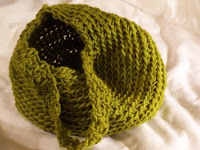
I've been wanting to try felting for a long
time. One day while browsing in Michael's, I impulsively bought several skeins of wool yarn. The yarn I chose was Patons Classic Wool in Aran (1), Dark Grey Mix (1), Leaf Green (2) and That's Pink (1). I used a 5.5mm hook, single crochet throughout, to create the individual pieces for my project, a tote bag.
I crocheted two side panels which measured about 17" x 17" before felting and one long green strip which was about 53" x 4" to go around the edge.
I did not use a pattern although I have seen similar totes to this in several books. I decided I wanted the slit-handle to be rolled down over the liner so I slipstitched the handle together, leaving the sides unattached so it could overlap the liner later. All of this was kind of off the cuff and I was interested to see how (and if) it would work.
I put somewhere between 12 and 15 hours into crocheting. I feel like my stitches have looked really good lately... which doesn't matter one iota when you're felting. It's amazingly forgiving as everything tends to matte and blend together, minor flaws melting in with the good stuff. Nonetheless, I put a lot of effort into the individual pieces... which makes throwing said good pieces into hot water slightly sickening.
feltingFor my purposes, I was interested in felting with hot water. There

are other methods that involve the use of needles and various tools to be used manually. I avoid needles and such as I am prone to accidents… and I would rather just let my washing machine do the work anyway.
There are multiple methods and rules for water felting—and they tend to contradict each other. Some people say to use very hot water. Others say not so hot that you can’t handle the piece. Some say to never
ever ever rinse in cold water, some say do. Some say spin, others say don’t. I decided to follow the closest thing I could find to manufacturer’s instructions which I found
here.
The hardest part was throwing the pieces into the hot water knowing it was about to be irreparably altered. And boy was it. It was amazing to pull a completely different product out of the machine. The strangest thing about the felted piece was how pliable it was while it was still damp. You have a certain ability to reshape the piece until it’s dry, then it’s game over.
I chose not to iron once I was done but I did have to do some minimal trimming where I had woven the ends back through from the color changes. Now you can’t tell anything was ever there.
I've read various info about how much size your piece should lose in the felting process. One website said the length and width shrink unevenly-- which is true I guess to some extent but my piece kept its original ratio for the most part. I did read that you can expect to lose about 30% and I would say that this was pretty accurate of my project. I'm sure it depends on the yarn you are using... The striped panels shrunk pretty evenly. The green strip ended up being about 4 or 5 inches too long but, with felting, you can just trim it to what you need as the stitches have all joined together and it behaves more like fabric.

I decided to hand-sew the bag together for the most part, out of fear that the fuzz could get caught in the foot pedal of a machine. It took several hours of hand work after which I remeasured to decide what size to make the lining. I did machine-sew the lining together then hand sewed it into the bag, finishing by folding the top edge down over the liner.
I love how the bag turned out. It’s actually better than I expected.
Anyway, I think I invested about $25 into supplies and 20-25 hours of my personal time. A hefty time investment (compared to the stuff I normally do) but I think well worth it. I did record my basic pattern as I went so I do have a record of how to recreate this bag for the most part.
Cheers!
 I'm dying to make a scarf like this. It's a free pattern which you can find here. I'm not sure that I would use the suggested yarn or colors even although I do really like this combination. I'm really liking cotton these days and I don't think there's a brown in the cotton brand I like.
I'm dying to make a scarf like this. It's a free pattern which you can find here. I'm not sure that I would use the suggested yarn or colors even although I do really like this combination. I'm really liking cotton these days and I don't think there's a brown in the cotton brand I like. 







